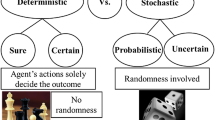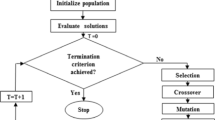Abstract
To avoid problems such as premature convergence and falling into a local optimum, this paper proposes an improved real-coded genetic algorithm (RCGA-rdn) to improve the performance in solving numerical function optimization. These problems are mainly caused by the poor search ability of the algorithm and the loss of population diversity. Therefore, to improve the search ability, the algorithm integrates three specially designed operators: ranking group selection (RGS), direction-based crossover (DBX) and normal mutation (NM). In contrast to the traditional strategy framework, RCGA-rdn introduces a new step called the replacement operation, which periodically performs a local initialization operation on the population to increase the population diversity. In this paper, comparisons with several advanced algorithms were performed on 21 complex constrained optimization problems and 10 high-dimensional unconstrained optimization problems to verify the effectiveness of RCGA-rdn. Based on the results, to further verify the feasibility of the algorithm, it was applied to a series of practical engineering optimization problems. The experimental results show that the proposed operations can effectively improve the performance of the algorithm. Compared with the other algorithms, the improved algorithm (RCGA-rdn) has a better search ability, faster convergence speed and can maintain a certain population diversity.








Similar content being viewed by others
References
Fogel LJ, Owens AJ, Walsh MJ (1966) Artificial intelligence through simulated evolution[C]// National Conference on Emerging Trends & Applications in computer science. Wiley-IEEE Press
Fogel DB (1998) Evolutionary computation: the fossil record[M]. Wiley-IEEE
Lenin K, Reddy B, Kalavathi M (2013) Collective animal behavior (CAB) algorithm for solving optimal reactive power dispatch problem[J]. International Electrical Engineering Journal (IEEJ) 4(4):1147–1158
Ali MZ, Awad NH, Suganthan PN et al (2017) An improved class of real-coded genetic algorithms for numerical optimization[J]. Neurocomputing
Elhoseny M, Tharwat A, Hassanien AE (2018) Bezier curve based path planning in a dynamic field using modified genetic algorithm[J]. J Comput Sci 25:339–350
Hussein HA, Demiroglu I, Johnston RL (2018) Application of a parallel genetic algorithm to the global optimization of medium-sized au–Pd sub-nanometre clusters[J]. Eur Phys J B 91(2):34
Chuang YC, Chen CT, Hwang C (2016) A simple and efficient real-coded genetic algorithm for constrained optimization[M]. Elsevier Science Publishers B V
Bi X, Wang C (2018) A niche-elimination operation based NSGA-III algorithm for many-objective optimization[J]. Appl Intell 48(1):118–141
Wang JQ, Chen ZW, Zhang PL, et al (2018) Research on improvement of real-coded genetic algorithm for solving constrained optimization problems[J]. Control and Decision
Biesinger B, Hu B, Raidl GR (2018) A genetic algorithm in combination with a solution archive for solving the generalized vehicle routing problem with stochastic demands[J]. Transp Sci 52:673–690
Lin HY, Lin CJ, Huang ML (2016) Optimization of printed circuit board component placement using an efficient hybrid genetic algorithm[J]. Appl Intell 45(3):1–16
Chen WH, Wu PH, Lin YL (2018) Performance optimization of thermoelectric generators designed by multi-objective genetic algorithm[J]. Appl Energy 209:211–223
Pathan MV, Patsias S, Tagarielli VL (2018) A real-coded genetic algorithm for optimizing the damping response of composite laminates[J]. Comput Struct 198:51–60
Metawa N, Hassan MK, Elhoseny M (2017) Genetic algorithm based model for optimizing bank lending decisions[J]. Expert Syst Appl 80:75–82
Elhoseny M, Tharwat A, Farouk A, Hassanien AE (2017) K-coverage model based on genetic algorithm to extend WSN lifetime[J]. IEEE Sensors Letters 1:1–4
Yuan XH, Elhoseny M, El-Minir HK et al (2017) A genetic algorithm-based, dynamic clustering method towards improved WSN longevity[J]. J Netw Syst Manag 25(1):1–26
Elhoseny M, Shehab A, Yuan XH (2017) Optimizing robot path in dynamic environments using genetic algorithm and Bezier curve[J]. J Intell Fuzzy Syst 33(4):2305–2316
Giassi M, Göteman M (2018) Layout design of wave energy parks by a genetic algorithm[J]. Ocean Eng 154:252–261
Lata S, Yadav SL, Sohal A (2017) Comparative study of different selection techniques in genetic algorithm[J]. Int J Eng Sci
Lozano M, Herrera F, Cano JR (2005) Replacement strategies to preserve useful diversity in steady-state genetic algorithms[J]. Inf Sci 178(23):4421–4433 2018, 91(2):34
Rao A, Chow PC, Gélinas S et al (2013) The role of spin in the kinetic control of recombination in organic photovoltaics.[J]. Nature 500(7463):435–439
Sundar S, Singh A (2017) Two grouping-based metaheuristics for clique partitioning problem[J]. Appl Intell 47(2):430–442
Thammano A, Teekeng W (2015) A modified genetic algorithm with fuzzy roulette wheel selection for job-shop scheduling problems[J]. Int J Gen Syst 44(4):499–518
Syswerda G (1989) Uniform crossover in genetic algorithms[C]. International Conference on Genetic Algorithms. Morgan Kaufmann Publishers Inc. 2–9
Jones S, Hinde CJ (2007) s. University of Aberdeen, Aberdeen
Eshelman LJ, Schaffer JD (1993) Real-coded genetic algorithms and interval-schemata[J]. Foundations of Genetic Algorithms 2:187–202
Deb K, Agrawal RB (1994) Simulated binary crossover for continuous search space[J]. Complex Syst 9(3):115–148
Ramteke M, Ghune N, Trivedi V (2015) Simulated binary jumping gene: a step towards enhancing the performance of real-coded genetic algorithm[J]. Inf Sci 325:429–454
Rodríguez JAM, Alanís FCM (2016) Binocular self-calibration performed via adaptive genetic algorithm based on laser line imaging[J]. J Mod Opt 63(13):1–14
García-Martínez C, Lozano M, Herrera F, Molina D, Sánchez AM (2008) Global and local real-coded genetic algorithms based on parent-centric crossover operators[J]. Eur J Oper Res 185(3):1088–1113
Deep K, Thakur M (2007) A new crossover operator for real coded genetic algorithms[J]. Appl Math Comput 188(1):895–911
Amjady N, Nasiri-Rad H (2009) Nonconvex economic dispatch with AC constraints by a new real coded genetic algorithm[J]. IEEE Trans Power Syst 24(3):1489–1502
Amjady N, Nasiri-Rad H (2010) Solution of nonconvex and nonsmooth economic dispatch by a new adaptive real coded genetic algorithm[J]. Expert Syst Appl 37(7):5239–5245
Kuo HC, Lin CH (2013) A directed genetic algorithm for global optimization[J]. Appl Math Comput 219(14):7348–7364
Miettinen K, Marko M et al (2003) Numerical comparison of some penalty-based constraint handling techniques in genetic algorithms[J]. J Glob Optim 27(4):427–446
Haghrah A, Mohammadi-Ivatloo B, Seyedmonir S (2015) Real coded genetic algorithm approach with random transfer vectors-based mutation for short-term hydro–thermal scheduling[J]. Generation Transmission & Distribution Iet 9(1):75–89
Khuat TT, Le MH (2016) A genetic algorithm with multi-parent crossover using quaternion representation for numerical function optimization[J]. Appl Intell:1–17
Ersavas C, Karatepe E (2016) Optimum allocation of FACTS devices under load uncertainty based on penalty functions with genetic algorithm[J]. Electr Eng 99(1):1–12
Si C, Shen J, Zou X, et al (2015) A dynamic penalty function for constrained optimization[M]// advances in swarm and computational intelligence. Springer International Publishing, pp 261–272
Ismkhan H (2018) Black box optimization using evolutionary algorithm with novel selection and replacement strategies based on similarity between solutions[J]. Appl Soft Comput 64:260–271
Xie XF, Zhang WJ, Yang ZL (2002) A parents selection strategy fighting premature convergence in floating genetic algorithms[J]. Control and Decision 17(5):625–628
Koumousis VK, Katsaras CP (2006) A saw-tooth genetic algorithm combining the effects of variable population size and reinitialization to enhance performance[J]. IEEE Trans Evol Comput 10(1):19–28
Kalayci CB, Polat O, Gupta SM (2016) A hybrid genetic algorithm for sequence-dependent disassembly line balancing problem[J]. Ann Oper Res 242(2):321–354
Deb K (2000) An efficient constraint handling method for genetic algorithms[J]. Comput Methods Appl Mech Eng 186(2):311–338
Lin CH (2013) A rough penalty genetic algorithm for constrained optimization[J]. Inf Sci 241(241):119–137
Mctavish T, Restrepo D (2008) Evolving solutions: the genetic algorithm and evolution strategies for finding optimal parameters[J]. Ann N Y Acad Sci 879(1):75–86
Jadrich RB, Lindquist BA, Bollinger JA, et al (2016) Consequences of minimising pair correlations in fluids for dynamics, thermodynamics and structure[J]. Mol Phys (16–17):1–13
Khezerlou AV, Alizadeh S (2014) A new model for discovering process trees from event logs.[J]. Appl Intell 41(3):725–735
Elsayed SM, Sarker RA, Essam DL (2014) A new genetic algorithm for solving optimization problems[J]. Eng Appl Artif Intell 27(C):57–69
Montemurro M, Vincenti A, Vannucci P (2013) The automatic dynamic penalisation method (ADP) for handling constraints with genetic algorithms[J]. Comput Methods Appl Mech Eng 256(256):70–87
Author information
Authors and Affiliations
Corresponding author
Appendix: List of test functions
Appendix: List of test functions
Rights and permissions
About this article
Cite this article
Song, Y., Wang, F. & Chen, X. An improved genetic algorithm for numerical function optimization. Appl Intell 49, 1880–1902 (2019). https://doi.org/10.1007/s10489-018-1370-4
Published:
Issue Date:
DOI: https://doi.org/10.1007/s10489-018-1370-4




